Excise tax in the United States is an indirect tax on listed items. Excise taxes can be and are made by federal, state and local governments and are not uniform throughout the United States. Some excise taxes are collected from the producer or retailer and not paid directly by the consumer, and as such often remain "hidden" in the price of a product or service, rather than being listed separately.

A revenue stamp, tax stamp, duty stamp or fiscal stamp is a (usually) adhesive label used to collect taxes or fees on documents, tobacco, alcoholic drinks, drugs and medicines, playing cards, hunting licenses, firearm registration, and many other things. Typically businesses purchase the stamps from the government, and attach them to taxed items as part of putting the items on sale, or in the case of documents, as part of filling out the form.
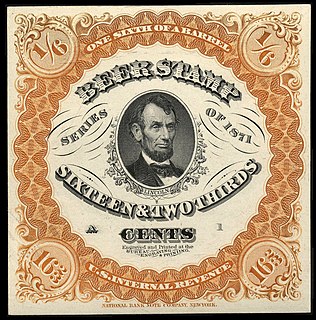
An excise, or excise tax, is any duty on manufactured goods that is levied at the moment of manufacture rather than at sale. Excises are often associated with customs duties ; customs are levied on goods that come into existence – as taxable items – at the border, while excise is levied on goods that came into existence inland.

In the United States cigarettes are taxed at both the federal and state levels, in addition to any state and local sales taxes and local cigarette-specific taxes. Cigarette taxation has appeared throughout American history and is still a contested issue today.

India has been a heavy user of revenue stamps, both before and after independence. The first revenues were issued in the mid-nineteenth century and they are still being issued to this day. Apart from issues for the whole of India, many princely states, provinces and other states also had or still have their own revenue stamp issues.
The Board of Inland Revenue Stamping Department Archive in the British Library contains artefacts from 1710 onwards, and has come into existence through amendments in United Kingdom legislation.

Revenue stamps of Malta were first issued in 1899, when the islands were a British colony. From that year to 1912, all revenue issues were postage stamps overprinted accordingly, that was either done locally or by De La Rue in London. Postage stamps also became valid for fiscal use in 1913, so no new revenues were issued until 1926–30, when a series of key type stamps depicting King George V were issued. These exist unappropriated for use as general-duty revenues, or with additional inscriptions indicating a specific use; Applications, Contracts, Registers or Stocks & Shares. The only other revenues after this series were £1 stamps depicting George VI and Elizabeth II. Postage stamps remained valid for fiscal use until at least the 1980s.

Revenue stamps of the United Kingdom refer to the various revenue or fiscal stamps, whether adhesive, directly embossed or otherwise, which were issued by and used in the Kingdom of England, the Kingdom of Great Britain, the United Kingdom of Great Britain and Ireland and the United Kingdom of Great Britain and Northern Ireland, from the late 17th century to the present day.
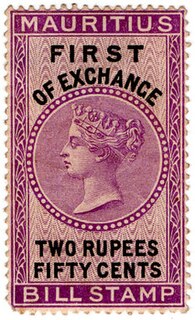
Mauritius issued revenue stamps from 1 March 1869 to 1904. There were various types of fiscal stamps for different uses.

Revenue stamps of Ireland refer to the various revenue or fiscal stamps, whether adhesive, directly embossed or otherwise, which have been used on the island of Ireland since 1774. These include issues by the Kingdom of Ireland, issues by the United Kingdom specifically for use in Ireland or briefly Southern Ireland, and issues of an independent southern Ireland since 1922. Revenue stamps of Northern Ireland were also issued from 1921 to the 1980s, but they are not covered in this article.
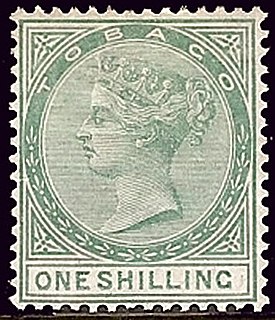
Trinidad and Tobago, formerly divided as two separate colonies, issued revenue stamps from 1879 to around 1991.
Bangladesh first issued revenue stamps in 1972, the year after independence, and continues to do so to this day. Previously Bangladesh used revenues of India from the 19th century to 1947, and those of Pakistan from 1947 to 1971. From 1921 to 1947 various Indian revenues were overprinted BENGAL for use in modern Bangladesh and West Bengal.
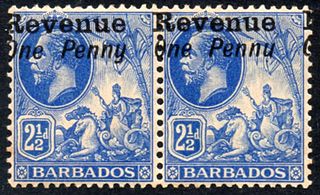
The island of Barbados first issued revenue stamps in 1916. There were various types of fiscal stamps for different taxes.
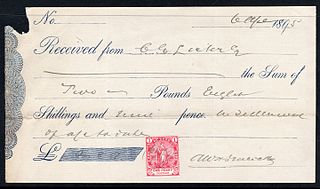
Cape of Good Hope issued revenue stamps from 1864 to 1961. There were a number of different stamps for several taxes.

Kenya, formerly known as British East Africa issued revenue stamps since 1891. There were numerous types of revenue stamps for a variety of taxes and fees. Also valid for fiscal use in Kenya were postage stamps issued by the following entities:

Rhodesia, now divided between Zambia and Zimbabwe, first issued revenue stamps in 1890, and Zimbabwe continues to do so to this day.

Revenue stamps of Jamaica were first issued in 1855. There were various types of fiscal stamps for different taxes.
Revenue stamps of Seychelles were first issued in 1893, when the islands were a dependency of the British Crown Colony of Mauritius. The first stamps were Mauritius Internal Revenue stamps depicting Queen Victoria overprinted for use in Seychelles, and Bill stamps were also similarly overprinted. Postage stamps depicting Victoria or Edward VII were overprinted for fiscal use at various points between 1894 and 1904, while surcharges on Bill stamps were made in around 1897–98.

Revenue stamps of Hawaii were first issued in late 1876 by the Kingdom of Hawaii to pay taxes according to the Stamp Duty Act of 1876, although embossed revenue stamps had been introduced decades earlier in around 1845. The stamps issued in 1876–79 were used for over three decades, remaining in use during the Provisional Government, the Republic and after Hawaii became a U.S. Territory. Some changes were made along the years: from rouletted to perforated, and some new values, colours, designs and overprints were added. Some postage stamps were briefly valid for fiscal use in 1886–88 to pay for a tax on opium imports, and a stamp in a new design was issued for customs duties in 1897. A liquor stamp was issued in 1905.

Revenue stamps of Northern Ireland refer to the various revenue or fiscal stamps, whether adhesive, directly embossed or otherwise, which were issued by and used in Northern Ireland, a constituent country of the United Kingdom. From 1774, various revenue stamps of Ireland were used throughout both Northern and Southern Ireland, while revenue stamps of the United Kingdom were also used to pay for some taxes and fees.
















